Time & Layering...
- amiedodgsonart
- Apr 20, 2020
- 5 min read
Updated: Apr 16, 2021
Initial Ideas Research for FMP
Idris Khan
London-based artist Idris Khan creates "minimal, yet emotionally charged photographs, videos and sculptures" and Sean Kelly Gallery state he is "without question one of the most exciting British artists of his generation". Khan draws on "diverse cultural sources including literature, history, art, music and religion and has developed a unique narrative involving densely layered imagery that inhabits the space between abstraction and figuration and speaks to the themes of history, cumulative experience and the metaphysical collapse of time into single moments." He photographs and scans from "secondary source material–sheet music, pages from the Qur’an and reproductions of late Caravaggio". He then goes onto painting and "builds up the layers of scans digitally, which allows him to control small variances in contrast, brightness and opacity. The resultant images are often large-scale C-prints with surfaces that have a remarkable optical intensity." The Sean Gallery states "his unique approach to creating densely layered imagery that inhabits the space between abstraction and figuration, collapsing time and cumulative experience into a single moment." (Sean Kelly Gallery, ca.2020)
Victoria Miro states that "Repetition and action have always been central to Khan's practice along with a restricted set of processes. Khan appears to suggest that our linear experience of time and place has a more shadowy relationship with memory and the subconscious, and that they cannot be so easily grasped."
"Whether working with the still or moving photographic image, painting on canvas or directly on to the wall, Khan retains an aesthetic of elegant saturation. The density and precision of his images allude to the excess of information in the technical age, while encouraging a slower and more engaged way of looking and responding to our collective history and culture. He creates an expanded sense of time." (Victoria Miro, ca.2020.)
Some of Idris Khan's work taken directly from The Saatchi Gallery website.

Figure 1: Idris Khan ~ Every...Bernd And Hilla Becher Gable Sided Houses, 2004. Photographic print, 208 x 160 cm.
"Since 1959 Bernd and Hilla Becher have been photographing industrial structures that exemplify modernist engineering, such as gas reservoirs and water towers. Their photographs are often presented in groups of similar design; their repeated images make these everyday buildings seem strangely imposing and alien. Idris Khan’s Every... Bernd And Hilla Becher... series appropriates the Bechers’ imagery and compiles their collections into single super-images. In this piece, multiple images of American-style gabled houses are digitally layered and super-imposed giving the effect of an impressionistic drawing or blurred film still." (Saatchi Gallery, ca.2020)

Figure 2: Idris Khan ~ Every...Bernd And Hilla Becher Prison Type Gasholders, 2004. Photographic print, 208 x 160 cm.
"The structures in the Bechers’ original photographs are almost identical, though in Khan’s hands the images’ contrast and opacity is adjusted to ensure each layer can be seen and has presence. Though Khan works in mechanised media and his images are of industrial subjects, their effect is of a soft ethereal energy. They exude a transfixing spiritual quality in their densely compacted details and ghostly outlines. ...Prison Type Gasholders conveys a sense of time depicted in motion, as if transporting the old building, in its obsolete black and white format, into the extreme future." (Saatchi Gallery, ca.2020)

Figure 3: Idris Khan ~ Every...Bernd And Hilla Becher Spherical Type Gasholders, 2004. Photographic print, 208 x 160 cm.
"The Bechers took their photos as a means to document a disappearing tradition; by grouping them according to ‘typology’ the buildings’ designs function like archetypal symbols or an architectural language. Through Khan’s translucent aggregations, structures such as ...Spherical Type Gasholders lose their commanding simplicity and rigid formalism and descend into fractured and gestural blurs. Through his photographs Khan compresses the timeline of repetition into indivisible subsuming moments and creates a poetic mutability from the fixed codes of history." (Saatchi Gallery, ca.2020)
Exhibition : London

"Idris Khan's London series was initially conceived in 2012 in response to a commission from the New York Times Magazine. For the project, he selected a group of London architectural landmarks, each one an intrinsic part of the capital city, indelibly bound to its fabric and history. The final images are an amalgam of between 70-100 layers of photographs of the same subject; sometimes using the whole image and at other times particular fragments, Khan worked with a variety of source material dating from the 1930's onwards, which included stock photographs as well as mass-produced tourist postcards. By a complex process of assembling and erasing he built up a pictorial palimpsest, stretched over time, which captured the essence of each iconic structure.
In order to realize these pieces as editions, Khan has chosen to use the Platinum-Palladium process. The technique is a hybrid of a photographic printing method first developed in the late 19th century and uses the salts of Platinum and Palladium. The process allows for a very distinctive and subtle tonal range, more so than is possible with silver gelatin prints, with a greater degree of colour variance between pure black and pure white. The result is a deeper, richer image with a greater emphasis on detail. The prints were made with the leading Platinum workshop – 31 Studio in Gloucestershire." (Krakow Witkin Gallery, 2016)
Julie Mehretu
Julie Mehretu is an Ethiopian born Artist that now lives in New York and produces clarge-scale, gestural paintings that are built up through layers of acrylic paint on canvas overlaid with mark-making using pencil, pen, ink and thick streams of paint. "Mehretu’s work conveys a layering and compression of time, space and place and a collapse of art historical references, from the dynamism of the Italian Futurists and the geometric abstraction of Malevich to the enveloping scale of Abstract Expressionist colour field painting. In her highly worked canvases, Mehretu creates new narratives using abstracted images of cities, histories, wars and geographies with a frenetic mark making that for the artist becomes a way of signifying social agency as well suggesting an unravelling of a personal biography." (White Cube Gallery, ca.2020)
"In exploring palimpsests of history, from geological time to a modern day phenomenology of the social, Julie Mehretu's works engage us in a dynamic visual articulation of contemporary experience, a depiction of social behavior and the psychogeography of space. Culled from archival sources-from ancient city plans, civic buildings, urban designs, public squares, tombs, palaces, ruins, etc-her paintings combine meticulous graphic drawing with spontaneous gesture. Mehretu begins with the premise of architecture as a medium of social history and power and proceeds to imagine a new present, a fictional topography realized through a formal vocabulary of line, color, gesture, markings, grids, characters, swarms, blurs, washes, which are overlaid and stratified on the surface of the canvas." (Maria Goodman Gallery, ca.2020)
“The narratives come together to create this overall picture that you see from the distance,” she says. “As you come close to it, the big picture completely shatters and there are these numerous small narratives happening.” (Mehretu on Artsy, ca.2020)
What attracted me to Mehretu's work was her use of abstract colour, line, form and shapes. The tools she uses to create these large scale paintings with so much emotion in them is really effective. To me, they look like images from the apocalypse, just as the world explodes from nuclear war. They also have a technological side to them, like the inside of a computer system.
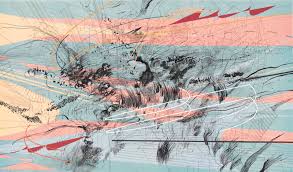
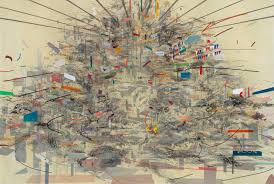
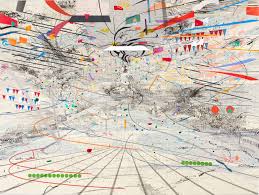
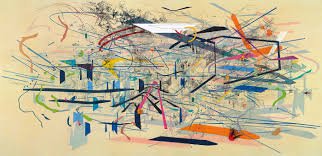
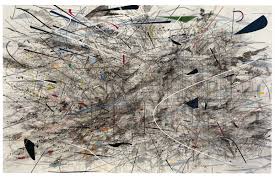
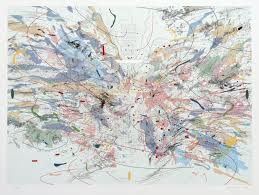
Comments